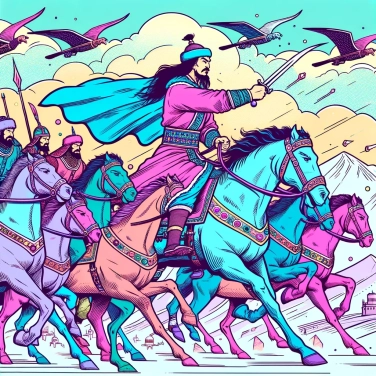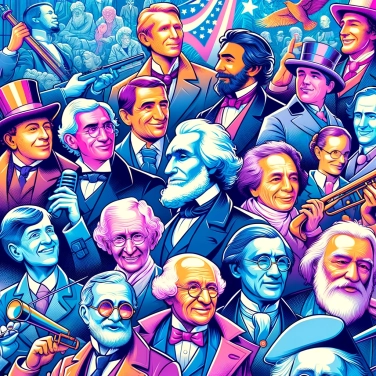Genghis Khan was able to build one of the largest empires in history thanks to his exceptional military skills, his ability to unify Mongol tribes, his shrewd political strategy, and his effective management of the empire once established.

Genghis Khan had a particular talent for uniting divided tribes through his natural charisma and strategic intelligence. He inspired trust and loyalty, which allowed him to gather very different warriors under one banner and a clear objective. This guy had a true vision, a clear idea of what he wanted to build in the long term. He knew where he wanted to go and how to lead men to follow him, notably by generously sharing the spoils and rewarding loyalty. With a formidable ability to seize opportunities and anticipate enemy reactions, Genghis often managed to be several moves ahead.
Genghis Khan had decided to organize his armies according to a very clear system, with a well-defined hierarchy. His army was structured into units of 10, 100, 1,000, and 10,000 soldiers, which gave him enormous responsiveness. Each unit had leaders chosen not for their social rank but solely based on their competence and ability to lead men on the battlefield. Discipline was extremely strict: fleeing or disobeying orders generally meant the death penalty. This strict yet fair approach maintained unwavering loyalty and soldiers always ready to rush into battle without hesitation. Because of this, the Mongols were able to move in the blink of an eye over enormous distances while remaining organized, and their speed was a nightmare for their enemies.
Genghis Khan built a formidable army by betting everything on his mounted archers, capable of shooting accurately while galloping at full speed. This ultra-mobile mode of combat created panic among his opponents, who were unable to anticipate or counter these lightning-fast attacks. His soldiers also had two major advantages: incredibly resilient horses that could survive in extreme conditions, and compact yet powerful bows, suited for quick shots on horseback. This combination gave his troops a significant tactical superiority, allowing them to surprise, encircle, or effectively pursue the enemy.
Genghis Khan knew that war alone is not enough to build a lasting empire. As a result, he often employed shrewd diplomacy to win without fighting, offering enemy tribes the chance to voluntarily rally to him rather than risk a battle that was lost before it began. His preferred method? Strategic alliances through marriage, cleverly marrying his children into influential families to cement political relationships. He generously rewarded those who became his allies, guaranteeing them protection and wealth, which encouraged other groups to quickly switch sides. And did he have spies or informants? Of course, he didn't shy away from that: his diplomatic networks also served to discreetly gather valuable intelligence. Thanks to this combination of skillful diplomacy, discreet intimidation, and pragmatic partnerships, he avoided wasting his forces and rapidly and sustainably expanded his territory.
Genghis Khan quickly understood the importance of being flexible towards newly conquered peoples. Rather than systematically imposing his way of life, he integrated useful knowledge, techniques, and resources from elsewhere (agriculture, administration, craftsmanship). He also understood a basic thing: tolerating religious and cultural differences greatly helps keep conquered populations calm. In short, instead of forcefully upheaving everything, he often preferred to adapt or blend others' ideas with his own. This led to much less guaranteed rebellion and significantly more sustainable adherence.
Modern genetic studies suggest that about one in 200 people in Central Asia may be direct descendants of Genghis Khan, highlighting the vast extent of his genetic legacy.
Despite his warrior image, Genghis Khan was also tolerant of different religions and cultures, even encouraging philosophical and religious debates in his capital, Karakorum.
Genghis Khan prohibited the abduction of women, banned certain forms of slavery, and established general legal protections, thereby creating a set of codified laws known as the 'Yassa'.
Genghis Khan established an efficient postal system called the 'Yam', connecting even the most distant provinces of his empire, enabling rapid communication in just a few days.
Genghis Khan was very flexible in cultural management by adopting the principle of religious tolerance and incorporating the customs of the conquered peoples. He valued individual talents and skills regardless of their origin, which promoted greater social stability and contributed to the internal cohesion of his empire.
The Mongol army was remarkably structured, based on an extremely precise decimal system: units of 10 (arban), 100 (zuun), 1,000 (minghan), and 10,000 soldiers (tumen). This organization allowed for great tactical flexibility and excellent coordination, facilitating rapid maneuvers and surprise attacks on the battlefield.
The Mongol cavalry, made up of exceptional mounted archers, was renowned for its speed and ability to fight in continuous motion. Mongol warriors were capable of shooting arrows accurately while riding at high speeds, making their attacks virtually unpredictable and devastating for their opponents.
Genghis Khan used diplomacy both through intimidation and strategic alliances. He often offered his enemies a clear choice: surrender with a degree of autonomy, or complete destruction. This approach sometimes avoided costly direct confrontations and allowed him to rally various peoples to his cause without always resorting to war.
Genghis Khan had a powerful charisma that allowed him to effectively unify various rival nomadic tribes. His clear strategic vision inspired deep loyalty, and he greatly rewarded merit and skills rather than family or social status. These qualities created a disciplined, loyal, and particularly motivated army, capable of making swift and decisive conquests.

No one has answered this quiz yet, be the first!' :-)
Question 1/5